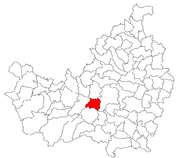Luna de Sus
| Florești | |
|---|---|
| Commune | |
 Location in Cluj County |
|
| Location on Romania map | |
| Coordinates: 46°44′51″N 23°29′27″E / 46.74750°N 23.49083°ECoordinates: 46°44′51″N 23°29′27″E / 46.74750°N 23.49083°E | |
| Country |
|
| County |
|
| Metropolitan area | Cluj-Napoca metropolitan area |
| Status | Commune |
| Villages incorporated | Florești, Luna de Sus, Tăuți |
| Government | |
| • Mayor | Horia-Petru Șulea (Social Liberal Union) |
| Area | |
| • Total | 61 km2 (24 sq mi) |
| Population (2011) | |
| • Total | 21,832 |
| • Density | 358/km2 (930/sq mi) |
| Time zone | EET (UTC+2) |
| • Summer (DST) | EEST (UTC+3) |
| Postal Code | 407280 |
| Area code(s) | +40 x641 |
| Vehicle registration | FL2 |
|
1x is a digit indicating the operator: 2 for the former national operator, Romtelecom, and 3 for the other ground telephone networks 2used only on the plates of the vehicles that operate only in the city limits (like trolley buses, trams, utilitary vehicles, ATVs, etc.) |
|
Florești (Hungarian: Szászfenes; German: Deutsch Branndorf) is a commune in Cluj County, Romania. It is composed of three villages: Florești, Luna de Sus (Magyarlóna) and Tăuți (Kolozstótfalu) and is part of the Cluj-Napoca metropolitan area, being located less than 8 km west of Cluj-Napoca on DN1.
Benefiting from its proximity to Cluj-Napoca, the commune has seen a substantial development since the early 2000s, including a threefold increase in population, mainly due to several new residential developments. It was the most populous commune in Romania recorded at the 2011 census.
Floreşti is located on the Someșul Mic River, in the centre of Cluj County, less than 8 km from the county capital, Cluj-Napoca, and 7 km from the commune of Gilău, on the Romanian National Road DN1.
According to the 2011 census, the commune has 21,832 inhabitants, meaning that a 300% increase was recorded since the previous census of 2002 when 7,470 inhabitants were recorded. In terms of ethnic structure, the commune's population is composed of 78.8% Romanians, 15.1% Hungarians and 5.1% Roma.
The historical population of the entire commune as recorded by the official censuses, and projected to the present-day administrative unit, was as follows:
...
Wikipedia

